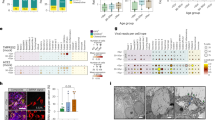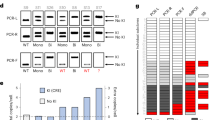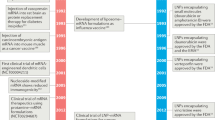Abstract
The Epstein–Barr virus M81 strain, isolated from a nasopharyngeal carcinoma, induces potent spontaneous virus production in infected B cells. We found that the M81 non-coding Epstein–Barr-encoded RNA EBER2, which carries polymorphisms that are mainly restricted to viruses found in endemic nasopharyngeal carcinomas, markedly stimulated this process. M81 EBER2 increased CXCL8 expression, and this chemokine enhanced spontaneous lytic replication levels in M81-infected B cells. Both events resulted from the endocytosis of extracellular vesicles containing EBER2 that were generated by neighbouring M81-infected B cells, thereby generating a paracrine loop. These effects were strictly dependent on a functional Toll-like receptor 7 (TLR7), a sensor of single-stranded RNA located in the endosome of these cells. These unique properties of M81 EBER2 could be ascribed to its unusually high expression level and to the ability of its single-stranded region to activate TLR7; both of these properties were dependent on M81-specific polymorphisms. Thus, M81 induced chronic inflammation in its target cells and this resulted in increased virus production. These observations provide a mechanistic molecular link between M81 virus replication—a central viral function and a cancer risk factor—and the production of a chemokine involved in inflammation and carcinogenesis.
This is a preview of subscription content, access via your institution
Access options
Access Nature and 54 other Nature Portfolio journals
Get Nature+, our best-value online-access subscription
$29.99 / 30 days
cancel any time
Subscribe to this journal
Receive 12 digital issues and online access to articles
$119.00 per year
only $9.92 per issue
Buy this article
- Purchase on Springer Link
- Instant access to full article PDF
Prices may be subject to local taxes which are calculated during checkout






Similar content being viewed by others
Data availability
The data that support the findings of this study are available within the article and its Supplementary Information files, or from the corresponding author upon request. The raw microarray data that support the findings of this study have been deposited at ArrayExpress, with accession no. E-MTAB-8102.
References
Rickinson, A. B. & Kieff, E. in Fields Virology 5th edn (eds Knipe, D. M. & Howley, P. M.) 2655–2700 (Lippincott: Williams & Wilkins, 2007).
Tsai, M. H. et al. Spontaneous lytic replication and epitheliotropism define an Epstein–Barr virus strain found in carcinomas. Cell Rep. 5, 458–470 (2013).
Young, L. S., Yap, L. F. & Murray, P. G. Epstein–Barr virus: more than 50 years old and still providing surprises. Nat. Rev. Cancer 16, 789–802 (2016).
Kieff, E. & Rickinson, A. B. in Fields Virology 5th edn (eds Knipe, D. M. & Howley, P. M.) 2603–2654 (Lippincott: Williams & Wilkins, 2007).
Klinke, O., Feederle, R. & Delecluse, H. J. Genetics of Epstein–Barr virus microRNAs. Semin. Cancer Biol. 26, 52–59 (2014).
Lerner, M. R., Andrews, N. C., Miller, G. & Steitz, J. A. Two small RNAs encoded by Epstein–Barr virus and complexed with protein are precipitated by antibodies from patients with systemic lupus erythematosus. Proc. Natl Acad. Sci. USA 78, 805–809 (1981).
Shen, Z. C. et al. High prevalence of the EBER variant EB-8m in endemic nasopharyngeal carcinomas. PLoS ONE 10, e0121420 (2015).
Correia, S. et al. Natural variation of Epstein–Barr virus genes, proteins, and primary microRNA. J. Virol. 91, e00375-17 (2017).
Palser, A. L. et al. Genome diversity of Epstein–Barr virus from multiple tumor types and normal infection. J. Virol. 89, 5222–5237 (2015).
Hui, K. F. et al. High risk Epstein–Barr virus variants characterized by distinct polymorphisms in the EBER locus are strongly associated with nasopharyngeal carcinoma. Int. J. Cancer 144, 3031–3042 (2019).
Correia, S. et al. Sequence variation of Epstein–Barr virus: viral types, geography, codon usage, and diseases. J. Virol. 92, e01132-18 (2018).
Pimienta, G. et al. Proteomics and transcriptomics of BJAB cells expressing the Epstein–Barr virus noncoding RNAs EBER1 and EBER2. PLoS ONE 10, e0124638 (2015).
Komano, J., Maruo, S., Kurozumi, K., Oda, T. & Takada, K. Oncogenic role of Epstein–Barr virus-encoded RNAs in Burkitt’s lymphoma cell line Akata. J. Virol. 73, 9827–9831 (1999).
Tsai, M. H. et al. The biological properties of different Epstein–Barr virus strains explain their association with various types of cancers. Oncotarget 8, 10238–10254 (2017).
Howe, J. G. & Shu, M. D. Epstein–Barr virus small RNA (EBER) genes: unique transcription units that combine RNA polymerase II and III promoter elements. Cell 57, 825–834 (1989).
Samanta, M., Iwakiri, D. & Takada, K. Epstein–Barr virus-encoded small RNA induces IL-10 through RIG-I-mediated IRF-3 signaling. Oncogene 27, 4150–4160 (2008).
Yang, L., Aozasa, K., Oshimi, K. & Takada, K. Epstein–Barr virus (EBV)-encoded RNA promotes growth of EBV-infected T cells through interleukin-9 induction. Cancer Res. 64, 5332–5337 (2004).
Iwakiri, D., Sheen, T. S., Chen, J. Y., Huang, D. P. & Takada, K. Epstein–Barr virus-encoded small RNA induces insulin-like growth factor 1 and supports growth of nasopharyngeal carcinoma-derived cell lines. Oncogene 24, 1767–1773 (2005).
Howe, J. G. & Steitz, J. A. Localization of Epstein–Barr virus-encoded small RNAs by in situ hybridization. Proc. Natl Acad Sci. USA 83, 9006–9010 (1986).
Ahmed, W., Philip, P. S., Tariq, S. & Khan, G. Epstein–Barr virus-encoded small RNAs (EBERs) are present in fractions related to exosomes released by EBV-transformed cells. PLoS ONE 9, e99163 (2014).
Ahmed, W., Tariq, S. & Khan, G. Tracking EBV-encoded RNAs (EBERs) from the nucleus to the excreted exosomes of B-lymphocytes. Sci. Rep. 8, 15438 (2018).
Mulcahy, L. A., Pink, R. C. & Carter, D. R. Routes and mechanisms of extracellular vesicle uptake. J. Extracell. Vesicles 3, 24641 (2014).
Thery, C., Amigorena, S., Raposos, G. & Claton, A. Isolation and characterization of exosomes from cell culture supernatants and biological fluids. Curr. Protoc. Cell Biol. 30, 3.22.1–3.22.29 (2006).
Flanagan, J., Middeldorp, J. & Sculley, T. Localization of the Epstein–Barr virus protein LMP 1 to exosomes. J. Gen. Virol. 84, 1871–1879 (2003).
Iwakiri, D. et al. Epstein–Barr virus (EBV)-encoded small RNA is released from EBV-infected cells and activates signaling from Toll-like receptor 3. J. Exp. Med. 206, 2091–2099 (2009).
Hanten, J. A. et al. Comparison of human B cell activation by TLR7 and TLR9 agonists. BMC Immunol. 9, 39 (2008).
Bencun, M. et al. Translational profiling of B cells infected with the Epstein–Barr virus reveals 5′ leader ribosome recruitment through upstream open reading frames. Nucleic Acids Res. 46, 2802–2819 (2018).
Barbalat, R., Ewald, S. E., Mouchess, M. L. & Barton, G. M. Nucleic acid recognition by the innate immune system. Annu. Rev. Immunol. 29, 185–214 (2011).
Lin, W., Yip, Y. L., Jia, L., Deng, W. & Zheng, H. Establishment and characterization of new tumor xenografts and cancer cell lines from EBV-positive nasopharyngeal carcinoma. Nat. Commun. 9, 4663 (2018).
Tsang, C. M. et al. Epstein–Barr virus infection in immortalized nasopharyngeal epithelial cells: regulation of infection and phenotypic characterization. Int. J. Cancer 127, 1570–1583 (2010).
Swaminathan, S., Tomkinson, B. & Kieff, E. Recombinant Epstein–Barr virus with small RNA (EBER) genes deleted transforms lymphocytes and replicates in vitro. Proc. Natl Acad. Sci. USA 88, 1546–1550 (1991).
Lee, N., Moss, W. N., Yario, T. A. & Steitz, J. A. EBV noncoding RNA binds nascent RNA to drive host PAX5 to viral DNA. Cell 160, 607–618 (2015).
Gregorovic, G. et al. Epstein–Barr viruses (EBVs) deficient in EBV-encoded RNAs have higher levels of latent membrane protein 2 RNA expression in lymphoblastoid cell lines and efficiently establish persistent infections in humanized mice. J. Virol. 89, 11711–11714 (2015).
Martin, H. J., Lee, J. M., Walls, D. & Hayward, S. D. Manipulation of the toll-like receptor 7 signaling pathway by Epstein–Barr virus. J. Virol. 81, 9748–9758 (2007).
Heil, F. et al. Species-specific recognition of single-stranded RNA via toll-like receptor 7 and 8. Science 303, 1526–1529 (2004).
Forsbach, A. et al. Identification of RNA sequence motifs stimulating sequence-specific TLR8-dependent immune responses. J. Immunol. 180, 3729–3738 (2008).
Baglio, S. R. et al. Sensing of latent EBV infection through exosomal transfer of 5′pppRNA. Proc. Natl Acad. Sci. USA 113, E587–E596 (2016).
Waugh, D. J. & Wilson, C. The interleukin-8 pathway in cancer. Clin. Cancer Res. 14, 6735–6741 (2008).
Thorley-Lawson, D. A. EBV persistence—introducing the virus. Curr. Top. Microbiol. Immunol. 390, 151–209 (2015).
Chien, Y. C. et al. Serologic markers of Epstein–Barr virus infection and nasopharyngeal carcinoma in Taiwanese men. New Engl. J. Med. 345, 1877–1882 (2001).
Shumilov, A. et al. Epstein–Barr virus particles induce centrosome amplification and chromosomal instability. Nat. Commun. 8, 14257 (2017).
Tischer, B. K., Smith, G. A. & Osterrieder, N. En passant mutagenesis: a two step markerless red recombination system. Methods Mol. Biol. 634, 421–430 (2010).
Feederle, R., Bartlett, E. J. & Delecluse, H. J. Epstein–Barr virus genetics: talking about the BAC generation. Herpesviridae 1, 6 (2010).
Lin, X. et al. The Epstein–Barr virus BART miRNA cluster of the M81 strain modulates multiple functions in primary B cells. PLoS Pathog. 11, e1005344 (2015).
Feederle, R. et al. Epstein–Barr virus B95.8 produced in 293 cells shows marked tropism for differentiated primary epithelial cells and reveals interindividual variation in susceptibility to viral infection. Int. J. Cancer 121, 588–594 (2007).
Feederle, R. et al. The Epstein–Barr virus lytic program is controlled by the co-operative functions of two transactivators. Embo J. 19, 3080–3089 (2000).
Feederle, R. et al. Epstein–Barr virus BNRF1 protein allows efficient transfer from the endosomal compartment to the nucleus of primary B lymphocytes. J. Virol. 80, 9435–9443 (2006).
Hessing, M., van Schijndel, H. B., van Grunsven, W. M., Wolf, H. & Middeldorp, J. M. Purification and quantification of recombinant Epstein–Barr viral glycoproteins gp350/220 from Chinese hamster ovary cells. J. Chromatogr. 599, 267–272 (1992).
Greijer, A. E. et al. Quantitative multi-target RNA profiling in Epstein–Barr virus infected tumor cells. J. Virol. Methods 241, 24–33 (2017).
Feederle, R. et al. A viral microRNA cluster strongly potentiates the transforming properties of a human herpesvirus. PLoS Pathog. 7, e1001294 (2011).
Van Deun, J. et al. EV-TRACK: transparent reporting and centralizing knowledge in extracellular vesicle research. Nat. Methods 14, 228–232 (2017).
Thery, C. & Witwer, K. W. Minimal information for studies of extracellular vesicles 2018 (MISEV2018): a position statement of the International Society for Extracellular Vesicles and update of the MISEV2014 guidelines. J. Extracell. Vesicles 7, 1535750 (2018).
Fitzgerald, W. & Freeman, M. L. A system of cytokines encapsulated in extracellular vesicles. Sci. Rep. 8, 8973 (2018).
Barrat, F. J. et al. Nucleic acids of mammalian origin can act as endogenous ligands for Toll-like receptors and may promote systemic lupus erythematosus. J. Exp. Med. 202, 1131–1139 (2005).
Acknowledgements
We thank the staff of the animal facility at DKFZ for their assistance with the animal experiments; the microarray unit of the DKFZ Genomics and Proteomics Core Facility for providing the Illumina Whole-Genome Expression Beadchips and related services; and J. M. Middeldorp (VU -University Medical Center, Amsterdam, Netherlands), for the OT6 antibody. This study was supported by German Cancer Research Center (F100), Institut National de la Santé et de la Recherche Médicale (U1074). Z.L. is supported by a stipend from the Chinese Scientific Council (CSC).
Author information
Authors and Affiliations
Contributions
H.-J.D. conceived and supervised the project. Z.L., M.-H.T. and H.-J.D. designed experiments. M.-H.T., F.B. and R.P. had significant input into the experimental design. Z.L. performed most of the experiments. R.P. conducted the EBER sequence alignment. Z.L., M.-H.T. and A.S. performed the mouse experiments. S.W.T. contributed the NPC43 and NP460hTert cell lines. Z.L., M.-H.T. and H.-J.D. analysed the data. Z.L. and H.-J.D. wrote the manuscript.
Corresponding author
Ethics declarations
Competing interests
The authors declare no competing interests.
Additional information
Publisher’s note: Springer Nature remains neutral with regard to jurisdictional claims in published maps and institutional affiliations.
Supplementary information
Supplementary Information
Supplementary Figs. 1–27 and Supplementary Tables 1 and 3–6.
Supplementary Table 2
Complete RNA microarray.
Rights and permissions
About this article
Cite this article
Li, Z., Tsai, MH., Shumilov, A. et al. Epstein–Barr virus ncRNA from a nasopharyngeal carcinoma induces an inflammatory response that promotes virus production. Nat Microbiol 4, 2475–2486 (2019). https://doi.org/10.1038/s41564-019-0546-y
Received:
Accepted:
Published:
Issue Date:
DOI: https://doi.org/10.1038/s41564-019-0546-y
This article is cited by
-
Cytoplasmic poly(A)-binding protein 1 (PABPC1) is a prognostic biomarker to predict survival in nasopharyngeal carcinoma regardless of chemoradiotherapy
BMC Cancer (2023)
-
Targeting the signaling in Epstein–Barr virus-associated diseases: mechanism, regulation, and clinical study
Signal Transduction and Targeted Therapy (2021)
-
Long non-coding RNAs in nasopharyngeal carcinoma: biological functions and clinical applications
Molecular and Cellular Biochemistry (2021)



